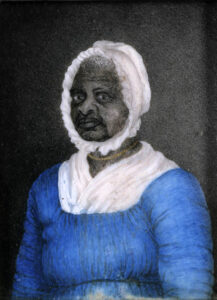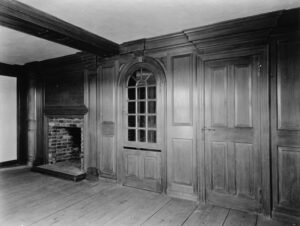“Any time, any time while I was a slave, if one minute’s freedom had been offered to me, and I had been told I must die at the end of that minute, I would have taken it, just to stand one minute on god’ airth a free woman–I would.”
— Elizabeth ‘Mumbet’ Freeman, as quoted by Catharine Sedgwick

Elizabeth ‘Mumbet’ Freeman at about 70 years old, painted by Susan Ridley Sedgwick in 1812. Image courtesy of Massachusetts Historical Society via Wikimedia.
If you’ve visited our offices on Francis Avenue in Pittsfield, you may have encountered Elizabeth ‘Mumbet’ Freeman, keeping steady watch above the fireplace in the conference room. Beside her is a plaque that reads, “Dedicated to honor the memory and values of the woman known as ‘Mum-Bett'”.
Courageous, clever, selfless, steadfast, iron-willed and independent, Elizabeth stood up to a great injustice and won. And yet, her story rarely appears in history books beyond a fleeting mention to the lawsuit that bore her name. So who was the “Bett” in Bett and Brom v. Ashley?
Life in the Ashley House
In 1780, the woman who would go on to name herself Elizabeth Freeman was known only as Bett, an enslaved laborer in the Sheffield home of Colonel John Ashley, and his wife, Hannah.

The Ashley House in Sheffield, where Elizabeth Freeman spent most of the first half of her life as a slave, was built by Colonel John Ashley and still stands today. Photo courtesy of the National Park Service.
Sent to the Ashley household as a wedding gift when she was only a teenager, Bett had spent decades serving Ashley and his fellow politically powerful, white revolutionaries as they spoke of liberty and independence in the upstairs study.
While his family’s five slaves cooked, cleaned, and managed the household, Ashley hosted the committee that drafted the Sheffield Declaration, a precursor to the Declaration of Independence written in 1773. Given her keen ear and perceptive nature, one passage in particular would have likely caught Bett’s attention:
“RESOLVED: That mankind in a state of nature are equal, free and independent of each other and have a right to the undisturbed enjoyment of their lives, their liberty and property.”

The Sheffield Declaration, a precursor to the Declaration of Independence, was drafted in the upstairs study of the Ashley House. Image courtesy of the National Park Service
Well-known in her later years as a healer and midwife, Bett had a reputation as a champion for the vulnerable even before she made her own bid for freedom. Hannah Ashley, mistress of the house, was infamous for her short temper and cruelty. In one incident, she discovered Bett’s sister, Lizzy, making herself a bit of bread using leftover dough from the mixing bowl. Enraged, Hannah picked up a red-hot kitchen shovel and attempted to strike her, but Bett blocked the hit with her own arm, sustaining a nasty wound in the process. As the story goes, she refused to cover the injury as it healed, instead keeping it on display as proof of Hannah’s abuse.
“Madam never again laid her hand on Lizzy. I had a bad arm all winter, but Madam had the worst of it. I never covered the wound, and when people said to me, before Madam,—’Why, Betty! what ails your arm?’ I only answered—’ask missis!’ Which was the slave and which was the real mistress?”
— Elizabeth Freeman, as quoted by Catharine Sedgwick
Brom and Bett v. Ashley
We can’t know for sure what finally drove Bett to leave the Ashley house, but an account by author Catharine Sedgwick, who grew up under Bett’s care, suggests it was a public reading of the newly ratified Massachusetts state constitution, which asserted that “All men are born free and equal.”

The initial Writ of Replevin, an order to return property, obtained by Theodore Sedgwick in May 1781 demanded that Colonel Ashley free Brom and Bett, as he did not have a legal claim of ownership to them. Image courtesy of mass.gov.
As the story goes, Bett showed up the very next day at the door of Theodore Sedgwick, a lawyer who had not only attended many of John Ashley’s political discussions, but written the Sheffield Declaration. She wanted to make her case in court.
“I heard that paper read yesterday, that says, all men are created equal, and that every man has a right to freedom,” she told him. “I’m not a dumb critter; won’t the law give me my freedom?”
Sedgwick agreed to take on the case as a test of slavery’s compatibility with the new constitution. He added another of Ashley’s slaves – a man named Brom – to the suit, possibly because the argument wouldn’t be taken as seriously if it was brought by a woman alone.
Brom and Bett weren’t the first black slaves to sue for their freedom in Massachusetts; by the time they entered the courtroom, nearly thirty others had already done the same. In those cases, however, arguments for freedom focused on loopholes, such as the petitioner being the child of a free woman and therefore entitled to her status, or having been promised a release that was never granted. Bett and Sedgwick’s case, on the other hand, was much simpler, and much more radical: Bett and Brom were owed freedom, because all people were owed freedom. It said so right there in the constitution.
Sedgwick obtained a writ of replevin — an order to recover property — in May of 1781, which instructed Colonel Ashley to immediately release Brom and Bett, as he had no rightful claim of ownership over them. When Ashley refused, Sedgwick moved forward with a lawsuit.

The written verdict in the Brom and Bett v. Ashley case, dated August 22, 1792. Image courtesy of mass.gov.
Brom and Bett v. Ashley went to the County Court of Common Pleas of Great Barrington on August 21, 1781. The next day, the all-white, all-male jury ruled that Brom and Bett were indeed granted their freedom under the Massachusetts constitution, and they were awarded immediate release from their enslavement as well as 30 shillings each and the cost of the trial.
Ashley initially appealed the decision, but withdrew when another high-profile freedom suit, Quock Walker v. Jennison, cited Bett’s case in its ruling that state law did not support slavery. By the time of the 1790 federal census, there were no recorded slaves in Massachusetts.
Becoming Elizabeth Freeman
Following the court decision, Bett changed her name to something more reflective of her new reality: Elizabeth Freeman. She joined the Sedgwick household as an independent (paid) domestic worker and governess, eventually saving enough to purchase a house and land for herself and her children.
Freeman’s defiant spirit never softened, even in victory. “Mum-Bett immediately transferred herself to the service of her champion, if service that could be called, which was quite as much rule as service,” Catharine Sedgwick wrote.
When the family fled to Boston during the unrest of Shay’s Rebellion, Freeman insisted she stay behind with a sick child who was under her care. Per Catharine’s account, she defended “her castle” by hanging a pot of beer over the fire and threatening to scald anyone who dare try to enter.
When she died in 1829, at an estimated 85 years of age, Freeman was buried in the innermost plot of the Sedgwick Cemetery – the only non-family member to be awarded the honor. Her tombstone, which still stands, bears an epitaph written by Theodore Sedgwick’s son, Charles. It reads:
“ELIZABETH FREEMAN
known by the name of
MUMBET
Died Dec 28, 1829
Her supposed age was 85 Years. She was born a slave and remained a slave for nearly thirty years. She could neither read nor write, yet in her own sphere she had no superior nor equal. She neither wasted time nor property. She never violated a trust, nor failed to perform a duty. In every situation of domestic trial, she was the most efficient helper, and the tenderest friend. Good Mother, farewell.”
Sources and related links:
“Elizabeth Freeman” at the National Women’s History Museum – an overview of Elizabeth’s life
“The Legacy of Elizabeth Freeman” at The Trustees of Reservations – with information about visiting the Ashley House, home of Colonel John Ashley, and celebrating Elizabeth Freeman Day on August 21
“Elizabeth Freeman, her case for freedom, and the Massachusetts Constitution” at the National Constitution Center – a look at the legal background and implications of Elizabeth’s case
“Massachusetts Constitution and the Abolition of Slavery” at the Massachusetts Supreme Judicial Court – a history of emancipation in Massachusetts, including Elizabeth’s contribution
“Slavery in New England” by Catharine Sedgwick – a recounting of major events in Elizabeth’s life, as told by her to Theodore Sedgwick’s daughter, Catharine
“How Elizabeth Freeman Sued for Her Freedom—and Won” at the History Channel – an in-depth telling of Elizabeth’s story with input from historians
